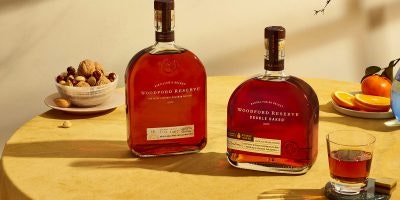Rum comes in many different shapes and sizes—spellings too. What you get in one part of the world might bear little resemblance to what’s distilled elsewhere. However, you always know what you’re going to get if a bottle is labeled Martinique rhum agricole. Rhum, as it is known locally, is made from fresh-pressed sugarcane juice—as opposed to the molasses or other saccharine by-products used in the majority of its sans-H counterparts.
By now you should be familiar with its tell-tale characteristics: earthy, sometimes even savory, with grit and grass. But are you aware of how much your local bartender likely loves working with the liquid? It’s true. Here’s why.
Quality Control
Rhum originating in the French Caribbean island of Martinique is actually protected with an Appellation d’Origine Contrôlée or an AOC.
A Rhum J.M. barrel / Photo Credit: Rhum J.M.
This is the same protection the French government affords to its provincial wines and cheeses. It doesn’t just demarcate the region, it establishes production standards for anything bottled with a Martinique AOC label. Aside from being produced from sugarcane grown on the island (which is dictated with regards to its varietals, harvest locations and yields, among other technical details), all aspects of its production from harvesting to bottling proof are controlled. So when H. Joseph Ehrmann pops open a bottle at his bar Elixir, in San Francisco, he is assured a caliber of excellence, every time. “There is little deviance from quality across the category,” he contends. “Most differences between brands and bottlings are in the specific house style.”
Education
If you’re lucky enough to know good bartenders, then you know they’re passionate about their trade, and not afraid to speak about it.
H. Joseph Ehrmann / Photo Credit: Liquor.com
Rhum agricole, still in its infancy here in the States, provides a terrific talking point. “The raw, grassy earthy nature of this style of rum supplies the kind of unique, interesting character I love in a good spirit,” Ehrmann says. “It takes a bit more education to the consumer to get them interested, but that’s what we specialize in, so it’s no problem for us.”
Terroir
But not everyone is so eager to talk it up. “Nooo! It needs to stay a secret on the West Coast,” jokes Kelso Norris of Genever in Los Angeles. “I don’t want it to go the way of mezcal.”
Trois Rivières Cuvée de l’Océan / Photo Credit: Rum Trois Rivières
Although she’s speaking to its susceptibility to overhyping, the two spirits actually already share a common thread by way of what they evoke: “The fresh sugarcane juice means it showcases the islands terroir—it’s grassy and earthy, fresh and funky,” she says. “Instead of the molasses and caramel flavors you’re used to in rum.” Much like with mezcal, rhum agricole imparts a strong sense of place in every sip.
“You can really taste the conditions it was grown in kind of like wine,” observes Devin Childress, head bartender at Viviane in Beverly Hills. “I have one at the bar that’s labeled Trois Rivieres’ Cuvee de l’Ocean. The cane grown for this bottle comes specifically from a plot that’s at the southernmost point of [Martinique], and during high tide the ocean actually washes through the sugarcane which creates a super crisp but saline taste to the funky island rum flavor. It’s instantly reminiscent of being at the beach or out on a sailboat and feeling the ocean spray.”
Versatility
Not to go overly geek, but rhum agricole distillation results in a liquid high in congeners and esters.
Rhum J.M. V.O. / Photo Credit: Rhum J.M.
In short, that means complexity of spirit and a wide range of funky flavors that can manifest themselves in a myriad of ways. “They are also much drier,” Ehrmann explains of typical agricole. “So they will be very different from a lot of rums that have a bunch of sugar added. On the aged products, there is a lot more French oak than American-ex bourbon barrels used than in most other rums, so that changes the profile on aged products.”
Cocktail Application
Of course, for any bartender to truly love a liquid, they have to be able to mix well with it. Rhum agricole is an ideal playmate—whether in Daiquiris, with a splash of soda, or in more elaborate tiki constructions.
A bartender pours cocktails using Rhum Clément / Photo Credit: Rhum Clément
“I also like using it in small amounts in cocktails to add depth,” says Norris. “It’s been around forever, but in relatively small production. Fingers crossed that humanity can respect the quality and skill that goes into it and not ruin it with industrialized swill for the masses!”
Here’s a sophisticated recipe to try at home, courtesy of barman Evan Hosaka.
COAL TRAIN
Coal Train Cocktail / Photo Credit: Rosina, The Palazzo Las Vegas
Rosina, The Palazzo Las Vegas
By: Evan Hosaka
– 1.25 oz Michter’s Rye
– 0.75 oz Clement 10 Year Grande Reserve Rhum Agricole
– 0.5 oz Tempus Fugit Crème de Banana
– 0.25 oz Amargo Vallet [Fernet works as a more widely available substitute)
– Lemon Twist
Add bitters, liqueur and spirits to a rocks glass. Add a big ice cube and stir. If you have one handy, use an ice stamp to imprint the ice cube, and finish with twist.
With Distiller, you’ll always know what’s in the bottle before you spend a cent. Rate, Review and Discover spirits! Head on over to Distiller, or download the app for iOS and Android today!



